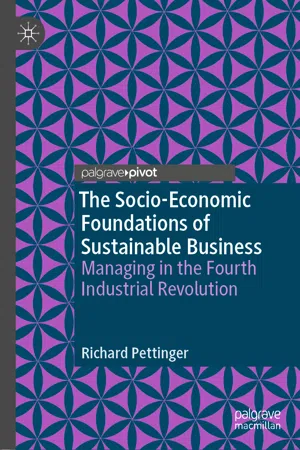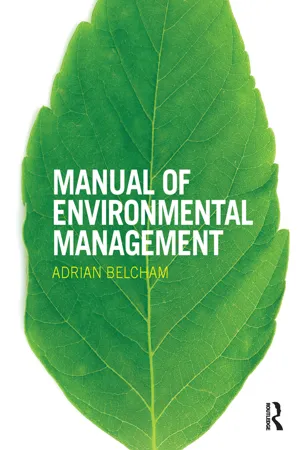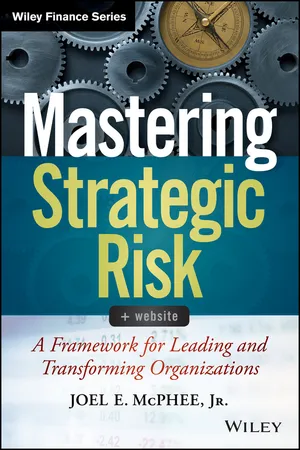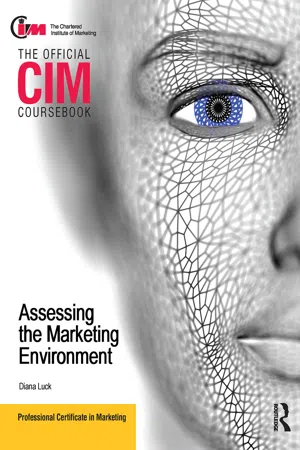Environment and Business
The environment and business are interconnected as businesses can have both positive and negative impacts on the environment. Environmental sustainability has become a key focus for businesses, leading to the development of green practices and technologies. Adhering to environmental regulations and implementing sustainable strategies can not only benefit the environment but also enhance a company's reputation and long-term success.
7 Key excerpts on "Environment and Business"
- eBook - ePub
- Alasdair Blair, David Hitchcock(Authors)
- 2004(Publication Date)
- Routledge(Publisher)
...1: Environment and Business: the nature of the relationships The basic elements—business, environment and environmentalism Impact of business on the environment The environment influencing business Business cultures and ethics The globalization of business Environmental and political standpoints Simple answers rarely suffice for complex problems; environmental and natural resources problems are not an exception. (Tom Tietenberg, 2000) The environment is in the process of becoming a major new competitive area for business. Understanding the impact of the relevant issues and responding to the resulting opportunities and threats will become an important source of competitive advantage. (Elkington and Burke, 1987) One of the main aims of this first chapter is to familiarize the reader with the relationships which are to be explored in this book. The relationships in themselves are relatively straightforward. First, business activities have an impact on the environment. This occurs through pollution, the modification of ecosystems, introducing exotic species and chemical compounds, genetic engineering and irreversible physical changes—the sorts of impacts widely reported in the popular press and television. The ways in which land has been used, particularly for agriculture and forestry, are a reflection of the way in which the commercial pressures of business have changed the physical landscape. Business affects the environment in a variety of ways both deliberate and accidental. Most of the effects are usually seen as detrimental, although increasingly we see some business activity improving the environment. For example, a number of museums and country houses have been opened to the public where the restoration of former days of glory have halted decades of decline and reinstated previous, albeit not entirely natural, surroundings...
- eBook - ePub
- Michael Lucas(Author)
- 2005(Publication Date)
- Routledge(Publisher)
...Introduction: The Concept of the Business Environment The aim of this book is to provide a framework for understanding what business decision-makers, academics and educationalists have come to call the ‘environment’. Everyday use of this word is loaded with images like the idyllic countryside, ‘green’ product labelling, ‘eco-warriors’ and many others linked to the ongoing debate about the treatment of our ‘natural’ environment. This book is not about that debate because in terms of the study of business ‘environment’ is a more all-embracing term. In a sense anything external to a business in the ‘outside’ world – may be thought of as part of the environment. As a subject of study, business environment is a notoriously ill-defined and messy amalgam of topics and issues which normally forms part of the introductory element of a business studies course. It is essentially rooted in the study of the academic disciplines often referred to as the social sciences namely economics, sociology, politics and law – without allowing students to delve into them in detail. More often than not it ends up as either an unconnected collection of theories from each of these disciplines or a current (or not so current!) affairs scrapbook. It is intended to provide a backdrop against which the ‘real’ subjects of business organisations and activities are taught. However, a thorough grounding in how to analyse the environment could offer great insights into other more developed areas of business studies, most notably decision-making, strategy and business ethics. This collection is my attempt to provide that grounding. Very few of the writers whose work I have included here would consider themselves to have been writing for business. The bulk of them are dispassionate ‘observers’ – journalists, academics and educationalists – of their ‘environments’ with no particular interest in peddling management solutions or pet theories of management...
- eBook - ePub
- Shunsuke Managi, Koichi Kuriyama(Authors)
- 2016(Publication Date)
- Routledge(Publisher)
...Global environmental problems, being such large-scale issues, demand an overhaul of social economic system foundations. This would, as a matter of fact, have enormous impacts on business practices. Therefore, putting environmental economics into practice not only involves simply being socially responsible, but also places importance on exceptional business management strategies and requires analyses to be made from perspectives of business competitiveness. However, regardless of the background conditions, what must always be borne in mind is that while firms do exist as social entities, they cannot continue to exist if they do not increase profits. The manner of responding to social demands is decided upon by each business upon its due consideration of how to adjust dividends to shareholders, prices of goods and services for consumers, employee wages, and other particulars. The benefit of CSR is that any third party can verify it. However, if it is not connected to specific profits, there will be no incentive to adopt it. The discussions throughout this section focus on the relationships between environmental and social performance and profits and costs. However, for firms in Japan, the U.S., and Europe, the perception that the sole social responsibility is to aggrandize profits is changing greatly over time. And, there have even been instances where there is a clear, positive correlation between CSR pursuits and increased profits. Section 6.3: Business and environmental risks What are environmental risks? Businesses take on a variety of risks, and among them, some are related to the environment. Environmental contamination that results from a mishap at a manufacturing plant, resulting in a cessation of plant operations and damage compensation to local residents, is a prime example...
- eBook - ePub
The Socio-Economic Foundations of Sustainable Business
Managing in the Fourth Industrial Revolution
- Richard Pettinger(Author)
- 2020(Publication Date)
- Palgrave Pivot(Publisher)
...© The Author(s) 2020 R. Pettinger The Socio-Economic Foundations of Sustainable Business https://doi.org/10.1007/978-3-030-39274-1_5 Begin Abstract 5. The Economic Environment Richard Pettinger 1 (1) School of Management, University College London, London, UK Richard Pettinger Email: [email protected] Abstract This chapter evaluates the environment from a far more detailed perspective than is usual. It especially draws attention to the social and behavioural issues that have to be considered. There is a far more detailed method proposed for addressing and classifying the different environmental factors that are of value to society as well as delivering the economic demands necessary. Keywords Organisations Organisation purpose Economic environment Competition Open and closed economies Analysing the environment Socio-technological approach End Abstract Introduction An organisation is any entity or body that is constituted for a given purpose, and which then establishes and conducts activities in pursuit of this purpose. Leaders, directors and managers are then employed by the owners and directors of organisations to run them on their behalf. Organisations are created on the basis that more can be achieved by people working in harmony and towards a stated purpose than by individuals acting alone. It is also more efficient and effective to specialise, at least to some extent, in seeking to serve or fulfil a given set of wants or needs. Resources, technology, expertise, information, finance and property can then be commanded and ordered for the stated purpose, within the constraints of the environment. The result of this is that society and the economy are more or less founded on a highly complex network of organisations, each of which serves a given purpose and all of which serve the entire range of purposes required. Organisations pervade all aspects of life—economic, social, political, cultural, religious, communal and family...
- eBook - ePub
- Adrian Belcham(Author)
- 2014(Publication Date)
- Routledge(Publisher)
...In a world of ever increasing demands in terms of productivity, employee satisfaction, attendance and morale are crucial and produce measurable benefits to an organisation. 4.7.2 Community pressures Society at both a local and wider level is becoming increasingly intolerant of poor environmental performance. Effective environmental management and increasing demands for openness and information are becoming a fundamental part of an organisation's licence to operate. At a local community level, poor reputation may translate into frequent complaints and objections to planning applications, permit renewals, etc. At a wider community level, press coverage and attention from non-governmental organisations (NGOs), such as Greenpeace, can translate into market pressures as sections of society express their disapproval through their spending powers. III MANAGING RISK AND ENHANCING OPPORTUNITIES The legal, financial, market and social pressures described above represent risks or opportunities to organisations depending on their response to and engagement with their environmental impacts. The first step in ensuring that risks are minimised and opportunities embraced is developing an understanding of where the organisation's sustainability priorities lie. In Chapter 1 we introduced the idea of ‘aspects and impacts’ as an approach developed in ISO 14001 that has become central to the way many organisations approach the assessment and prioritisation of their environmental issues. Chapter 6 deals with risk assessment tools and techniques in some detail but here we will elaborate on the longer-term issues associated with sustainability strategy as well as the general principles of risk management. 4.8 Sustainability threats and opportunities The long-term implications of sustainability are profound for all organisations...
- eBook - ePub
Mastering Strategic Risk
A Framework for Leading and Transforming Organizations
- Joel E. McPhee(Author)
- 2014(Publication Date)
- Wiley(Publisher)
...While consumption through needs and desires spawns what becomes the lifeblood of the commercial ecosystem (goods and services), this dynamic in turn is the catalyst to job creation. Job creation not only provides us with the means to purchase goods and services, thereby sustaining ourselves, but enables to pursue work that provides us with meaning. And the final cog in this important wheel is always the environment because it supports it all through the natural resources and the food we consume. Because of this interdependence, the self-interests of individuals and industry, if not held in check, would overwhelm our already strained environment. This new perspective not only explains how symbiotic the stakeholders are but presents a compelling case for why we must transcend our collective self-interests in furtherance of a more aggressive plan to address the sustainability and the environment. Bringing forward how dependent these three stakeholders are provides a formidable business case regarding the environmental sustainability. It demonstrates how the overall health and long-term profitability of commercial activities are directly tied to environmental concerns. Industry, as a key stakeholder in this web of relationships, must take a more active role in addressing and mitigating issues tied to the environment. Consider the work that the multinational corporation Unilever is doing in the area of sustainability and the environment. Driving Growth and Shareholder Value through Sustainability Possessing a rich history of pioneering social responsibility, it’s no wonder Unilever is a global leader in corporate sociability. The company produces products that represent the highest standards of quality, are socially and environmentally responsible, and reflect strong input from the communities it serves. Unilever quite simply produces products for a global customer base that enhance and improve the quality of life for individuals throughout its massive global footprint...
- Diana Luck(Author)
- 2010(Publication Date)
- Routledge(Publisher)
...They are becoming more organised and professional in approaching both government and companies. They are now more adept at marketing their causes and highlighting the deficiencies of companies towards their stakeholder groups. Green consumers’ guides and Friends of the Earth green con awards are examples of how a business’ reputation can be soiled. To minimise such risks, a company must establish and apply values and beliefs conducive to a sustainable business. Companies must be aware of the threats and opportunities of enhancing their reputation in the eyes of stakeholders through effective and well-managed policies towards the environment. Unilever and the World Wildlife Fund for Nature, for example, agreed on a sustainable standard for fish products with a special logo if the product was from accredited fishing grounds. FURTHER STUDY AND EXAMINATION PREPARATION Since the marketing environment links the organisation with external constraints, opportunities and threats, it is unsurprising that questions frequently arise requiring you to explore the relationship between the two. While the syllabus content of this chapter is around 10 per cent, its significance extends much wider in terms of questions and part questions appearing at regular intervals on CIM papers. Attempt to show that you are aware of the role of the key players and less prominent players within the marketing process. Show your appreciation of the factors within the macro-environment and of the micro-environment. OTHER SUGGESTED READING Bassington F. and Pettitt S. (2003), Principles of Marketing, Pearson Education Limited. Chapter 1 : Marketing dynamics Chapter 2 : The European marketing environment Jobber D. (1998), Principles of Marketing, McGraw-Hill, 2nd Ed. Chapter 5 : The marketing environment Lancaster G., Massingham L., and Ashford R...






